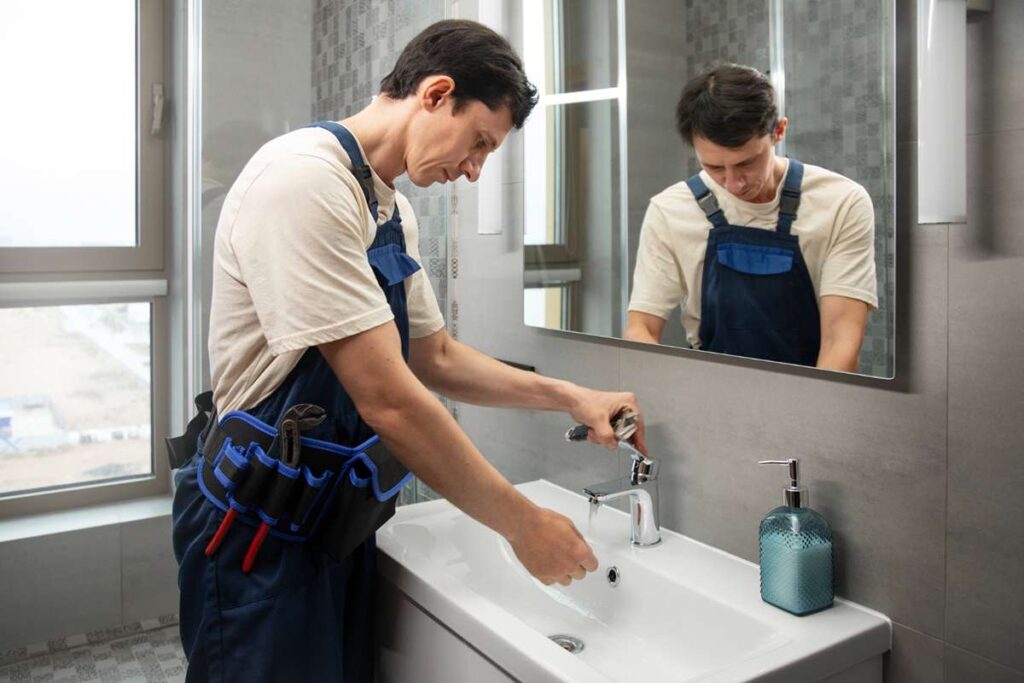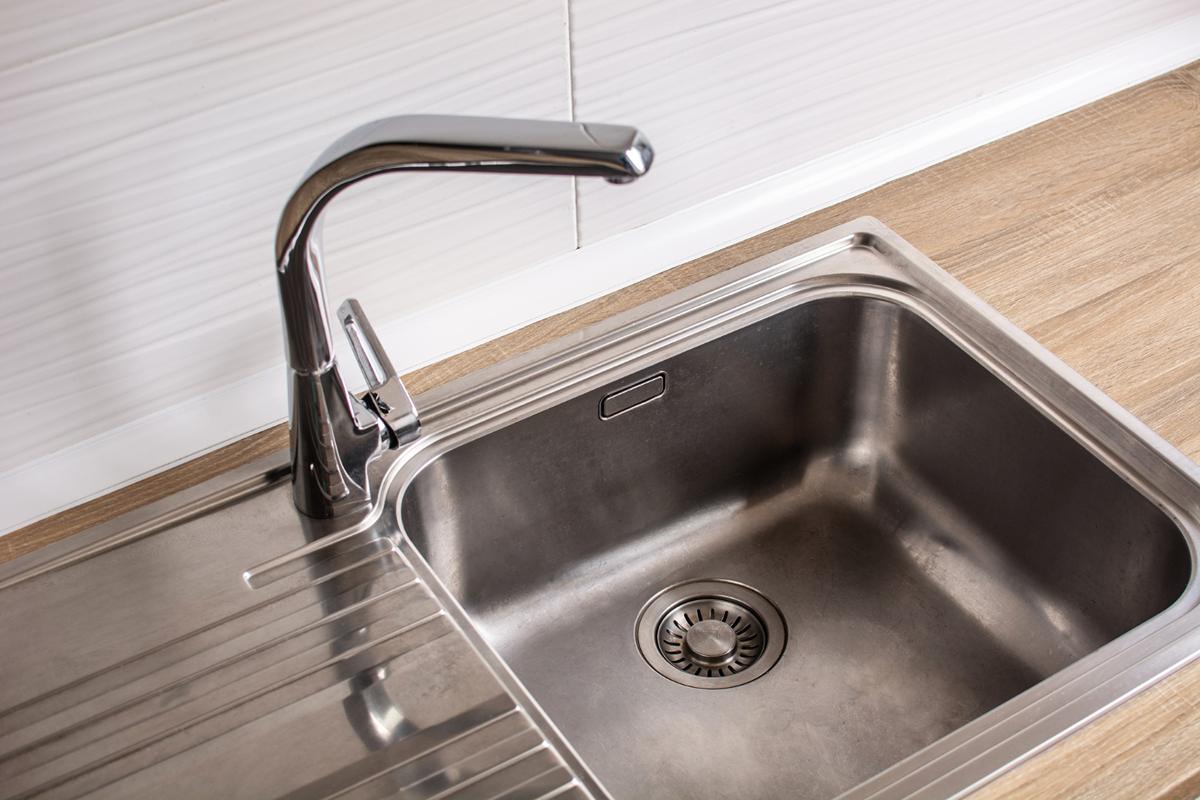Have you ever seen a deep sink in a janitor’s closet or restaurant kitchen and wondered what it’s for? That’s called a service sink. It’s a strong and deep sink used for cleaning dirty tools, mops, and buckets. These sinks are super useful in homes, schools, hospitals, and restaurants where things get really messy. They help keep everything clean and safe. In this article, you’ll learn what is a service sink, how it’s different from a utility sink, where it’s used, and what to look for when buying one. Let’s explore how this powerful sink makes cleaning easier!
What Is a Service Sink?
A service sink is a deep, heavy-duty sink made for tough cleaning jobs. It’s not like the regular sink you use in the kitchen or bathroom. Instead, it’s used to clean dirty mops, dump waste water, and wash large tools or buckets. That’s why many people also call it a janitorial sink, mop sink, or even a wall-mounted sink when it’s attached to a wall.
You’ll mostly find service sinks in places like janitor closets, utility rooms, restaurants, schools, and even hospitals. They’re designed to handle messy tasks and keep workspaces clean and safe from germs or spills.
What Is a Service Sink Used For?
A service sink is made for tough cleaning jobs that a regular sink can’t handle. It’s not used for washing hands or food—it’s built to deal with messes that come from cleaning work. This includes dirty water, mops, tools, and big items that just don’t fit in a normal sink.
Here’s what a service sink is commonly used for:
Rinsing dirty cleaning gear like mops and brushes
Emptying mop buckets without making a mess on the floor
Cleaning large items that are too big for kitchen or bathroom sinks
Safely draining dirty or soapy water from cleaning jobs
Preventing cross-contamination by separating dirty tasks from food or handwashing
What Is a Service Sink Used for in a Restaurant?
In a busy restaurant, keeping the kitchen clean is super important—and that’s where the service sink plays a big role. These sinks help with commercial cleaning tasks that can’t be done in regular handwashing or food-prep sinks.
Restaurants use service sinks to:
- Rinse mops and clean tools used in the kitchen and dining area
- Empty dirty water safely without using food-prep sinks
- Avoid cross-contamination between food and cleaning waste
- Keep the kitchen safe and hygienic by having a separate space for messy jobs
Service Sink vs Utility Sink
People often confuse a service sink with a utility sink, but they’re not the same. While both are used for cleaning, they serve different purposes.
A utility sink is usually found in homes, like in a garage or laundry room. It’s great for washing paint brushes, rinsing clothes, or cleaning light messes. On the other hand, a service sink—also known as a slop sink or deep basin sink—is built for heavier-duty cleaning, often in commercial places.
Here’s a quick comparison:
| Feature | Service Sink | Utility Sink |
| Purpose | For cleaning tools/mops | For general home use |
| Location | Janitor closet, restaurants | Garage, laundry rooms |
| Design | Deep bowl, floor-mounted | Shallow, top-mounted |
| Water Disposal | Dirty/chemical water | Light household water |
When Should You Use Each One?
- Choose a service sink if you need to clean large or very dirty items, like mops or buckets, or if you’re in a commercial setting.
- Go for a utility sink if you just need a simple wash-up space for small tasks around the house.
Key Features of a Good Service Sink

When choosing a service sink, it’s important to look for features that make it durable, practical, and easy to use. Here are the key features that make a good service sink stand out:
- Heavy-duty Material
A service sink should be made of strong, long-lasting materials like stainless steel or ceramic. These materials can handle heavy cleaning tasks, resist rust, and are built to last in busy environments like kitchens, schools, or janitor closets. - Splash Guards or Tall Sides
To prevent water from splashing out, a good service sink will have splash guards or tall sides. This feature keeps the mess contained and makes cleaning tasks much easier and safer. - Wall or Floor-Mounted
Service sinks can be either wall-mounted or floor-mounted. Wall-mounted sinks save space and are great for areas with limited room. Floor-mounted sinks, on the other hand, provide more stability and are ideal for heavy-duty cleaning. - Easy to Clean
Because service sinks handle a lot of mess, it’s important that they are easy to clean. Look for sinks with smooth surfaces and simple designs that don’t trap dirt or chemicals.
Where Can You Install a Service Sink?
A service sink is a versatile tool, and it can be installed in many different places depending on your needs. Here are the best spots to install a service sink:
At Home:
Laundry Rooms: A service sink in the laundry room is perfect for rinsing out clothes, washing dirty tools, or cleaning pet messes.
Basements: Basements often become catch-alls for cleaning tasks, and a service sink is ideal for handling large or messy cleaning jobs down there.
In Businesses:
Restaurants: Service sinks are essential in restaurant kitchens for cleaning mops, emptying dirty water, and preventing cross-contamination.
Schools: In schools, service sinks help with cleaning janitorial equipment and handling messes from classrooms or gyms.
Hospitals: In hospitals, they are used to clean and disinfect equipment, keeping workspaces safe and sanitary.
Tips for Choosing the Right Location:
- Access: Choose a location that’s easy to access but separate from food-prep or hand-washing areas.
- Water Drainage: Ensure that the location has proper drainage and is close to water pipes for easy installation.
- Space: Consider the space available. Wall-mounted sinks save room in tight spots, while floor-mounted ones are better for larger, heavy-duty tasks.
Expert Advice on Installation
If you’re unsure about where to install your service sink, it’s always a good idea to consult a professional plumber. They can help ensure the sink is installed safely and properly, preventing plumbing issues in the future.
How to Maintain a Service Sink Properly
Proper maintenance of your service sink ensures it stays clean, functional, and long-lasting. Here are some easy tips to keep your sink in top condition:
Regular Cleaning with Disinfectant
Make sure to clean the sink regularly using a disinfectant to remove dirt, grime, and bacteria. This helps prevent unpleasant odors and keeps the sink sanitary, especially if it’s used for dirty jobs.
Avoid Dumping Grease or Food
Never dump grease, food, or chemical liquids down your service sink. These substances can clog the drain, cause odors, and damage the plumbing. Always dispose of them properly.
Use Proper Plumbing
Ensure the plumbing is set up correctly to handle the flow of dirty water and heavy-duty cleaning. Proper installation helps prevent leaks, clogs, and damage to your sink and pipes.
Do’s and Don’ts for Maintaining a Service Sink
Do’s:
- Clean the sink regularly with mild cleaning agents to prevent build-up.
- Use a strainer to catch debris and prevent it from clogging the pipes.
- Check the plumbing for leaks or signs of wear and tear.
- If the sink is in a commercial space, make sure it’s cleaned daily by the janitorial staff.
Don’ts:
- Don’t dump grease, oils, or chemicals down the sink.
- Don’t use harsh cleaners like bleach or acidic solutions that can damage the surface.
- Don’t overload the sink with items too large or heavy for it to handle.
- Don’t neglect plumbing issues; fix them promptly to avoid costly repairs.
What to Look for When Buying a Service Sink

When shopping for a service sink, it’s important to choose one that suits your needs, is durable, and fits your space. Here are the key things to consider:
Materials: Ceramic vs. Stainless Steel
The material of your service sink determines its durability and maintenance needs.
Ceramic sinks are stylish, easy to clean, and resistant to stains but can crack under heavy use.
Stainless steel sinks are extremely durable, easy to sanitize, and perfect for commercial settings. They are often the best choice for heavy-duty cleaning tasks.
Size and Depth
Choose a sink with the right size and depth for your tasks. A deeper sink is ideal for washing large items like mop buckets or cleaning tools, while a wider sink provides more space for rinsing and draining.
Drain System and Durability
Make sure the drain system is robust and can handle heavy flow, especially if you’ll be dumping large amounts of water or cleaning fluids. The durability of the sink’s structure and plumbing system is also crucial to avoid leaks or corrosion over time.
Brand Quality
Choosing a reliable brand ensures you get a high-quality sink that lasts for years. Trusted brands like Lowe’s and Home Depot offer a wide selection of service sinks with good warranties and customer reviews. Here are some helpful links to get started:
Expert Tips
Before buying, always check expert reviews and installation advice. If you’re unsure about the right model, ask a professional plumber for recommendations. Their expert insights can help you choose the best service sink based on your space and cleaning needs.
FAQs
1. What is the purpose of a service sink?
A service sink is designed for cleaning tools, mops, and other equipment used in heavy-duty cleaning tasks. It is used to drain dirty water and avoid clogging regular sinks.
2. What is the difference between a service sink and a bathroom sink?
A service sink is deeper, more durable, and built for cleaning tasks, while a bathroom sink is shallow and meant for hand washing and personal hygiene.
3. What is the difference between a floor sink and a service sink?
A floor sink is installed directly into the floor and is primarily used for draining wastewater from plumbing systems, while a service sink is typically mounted on the wall and used for cleaning equipment.
4. What are the three main types of sinks?
The three main types of sinks are utility sinks (for heavy-duty cleaning), kitchen sinks (for food prep and dishwashing), and bathroom sinks (for personal use and hygiene).
5. Can you wash your hands in a service sink?
No, service sinks are not meant for washing hands or food-related tasks. They are designed for cleaning equipment, draining dirty water, and other heavy-duty uses.
6. Can a service sink be installed outside?
Yes, a service sink can be installed outside, especially in areas like garages, outdoor kitchens, or cleaning stations, provided the plumbing is done correctly to prevent freezing.
7. How deep should a service sink be?
A service sink should typically have a depth of 12 to 18 inches to accommodate large items like mops and buckets, ensuring easy cleaning without overflow.
8. Are service sinks used in restaurants?
Yes, service sinks are common in restaurants, where they are used for cleaning large kitchen tools, draining dirty water, and maintaining cleanliness in the back-of-house areas.
Conclusion
In conclusion, a service sink is a heavy-duty, versatile sink designed for tasks like cleaning tools, mops, and emptying dirty water. It’s built to withstand tough cleaning jobs and is commonly found in places like janitor closets, laundry rooms, and restaurants.
Choosing the right service sink for your needs is essential, whether it’s for home or business use. Keep in mind the material, size, and drain system when selecting a sink, and don’t forget the importance of proper maintenance to ensure it lasts.










